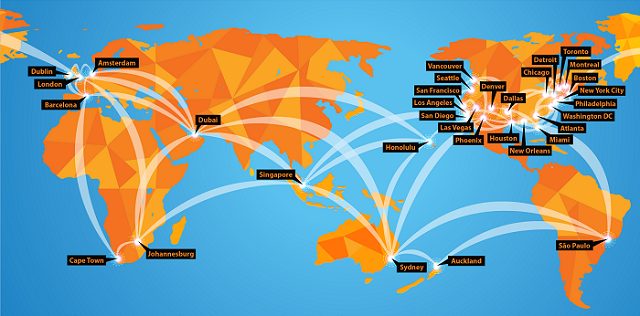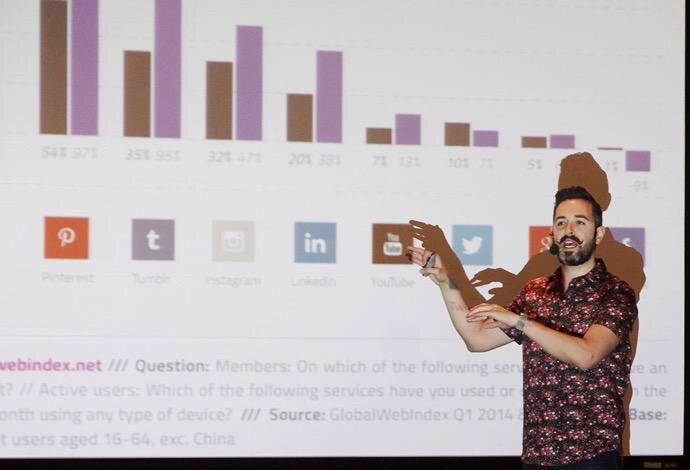Posts Tagged "Conversion Rate Optimization"
Articles
- Best Marketing Conference Sponsorship
- What Does it Mean to Be an Exhibitor at a Conference?
- What Is the Biggest Social Media Conference?
- What Is an Innovation Conference?
- What Is a Typical B2B Event?
- What Are the Cloud Technology Events in 2025?
- Marketing Event Volunteer Opportunities: A Comprehensive Guide
- Digital Marketing Event Volunteer Opportunities Near Me
- What Does a Volunteer Do at a Conference?
- Is DigiMarCon Worth It?
- Is DigiMarCon Good?
- What is the Biggest Marketing Forum?
- What are Digital Marketing Conferences?
- Marketing Conference Exhibiting: Your Guide to Success
- Digital Summit Comparison: A Closer Look at DigiMarCon
- Digital Marketing Conference
- Digital Marketing Events: Your Guide to Success in 2025
- Marketing Conferences: Unlocking Your Business Potential in 2025
- What Is The Future of Digital Marketing in 2030?
- B2B Event Marketing Strategy: Unlocking Success For Your Business
- Why B2B Event Marketing?
- What Should a B2B Marketing Strategy Include?
- Top Marketing Conferences for 2025
- What Is the Future of Marketing in 2025?
Digital Marketing Conferences
- NORTH AMERICA
- DigiMarCon Cruise
(New Orleans, LA, USA) - DigiMarCon West
(Los Angeles, CA, USA) - DigiMarCon Northwest
(Seattle, WA, USA) - DigiMarCon Canada West
(Vancouver, BC, USA) - DigiMarCon Canada
(Toronto, ON, Canada) - DigiMarCon Canada East
(Montreal, QC, Canada) - DigiMarCon Florida
(Orlando, FL, USA) - DigiMarCon Gulf Coast
(Houston, TX, USA) - DigiMarCon Southern California
(San Diego, CA, USA) - DigiMarCon Midwest
(Chicago, IL, USA) - DigiMarCon Mid-South
(Nashville, TN, USA) - DigiMarCon Great Lakes
(Detroit, MI, USA) - DigiMarCon North
(Minneapolis, MN, USA) - DigiMarCon Central
(Kansas City, MO, USA) - DigiMarCon Texas
(Dallas, TX, USA) - DigiMarCon New England
(Boston, MA, USA) - DigiMarCon Mid-Atlantic
(Philadelphia, PA, USA) - DigiMarCon South Florida
(Miami, FL, USA) - DigiMarCon Southeast
(Atlanta, GA, USA) - DigiMarCon Central Florida
(Tampa, FL, USA) - DigiMarCon East
(New York, NY, USA) - DigiMarCon South Atlantic
(Charlotte, NC, USA) - DigiMarCon America
(Washington, D.C. USA) - DigiMarCon Northern California
(San Francisco, CA, USA) - DigiMarCon Rocky Mountains
(Denver, CO, USA) - DigiMarCon South
(San Antonio, TX, USA) - DigiMarCon Silicon Valley
(San Jose, CA, USA) - DigiMarCon Orange County
(Anaheim, CA, USA) - DigiMarCon Southwest
(Phoenix, AZ, USA) - DigiMarCon World
(Las Vegas, NV, USA)
- DigiMarCon Cruise
- LATIN AMERICA
- EUROPE
- MIDDLE EAST
- AFRICA
- ASIA PACIFIC
- DigiMarCon Hawaii & Pacific
(Honolulu, HI, USA) - DigiMarCon Asia & Japan
(Tokyo, Japan) - DigiMarCon New Zealand
(Auckland, New Zealand) - DigiMarCon Australia
(Sydney, Australia) - DigiMarCon Oceania
(Melbourne, Australia) - DigiMarCon Southeast Asia
(Singapore) - DigiMarCon India
(New Delhi, India) - DigiMarCon North Asia & China
(Shanghai, China)
- DigiMarCon Hawaii & Pacific
- VIRTUAL
Digital Marketing Blog
- What Makes DigiMarCon Stand Out (And Is It Worth It?) October 30, 2025
- Is DigiMarCon Worth Attending? A Complete Breakdown October 29, 2025
- DigiMarCon for Startups: Why Founders Shouldn’t Miss It October 29, 2025
- DigiMarCon Recap: What Went Down and What’s Next October 29, 2025

































Predictive Analytics & Attribution: Insights for Success
In today’s world, knowing how customers behave is key to success. Predictive analytics and attribution help businesses understand their marketing better. This way, they can make smart choices and grow.
Marketers can now analyze complex data and see how their efforts pay off. This changes the game by helping them improve their plans. They can use their resources better and reach their goals.
Key Takeaways
The Data Revolution in Marketing
Data is changing marketing in big ways. Marketers now have lots of data to help them make smart choices. This move to data-driven marketing is changing how businesses talk to customers and plan their strategies.
Marketing data analysis is key in this change. It helps marketers know what customers want, see how well campaigns do, and find new chances. With the right tools, businesses can really get to know their audience and make their marketing better.
The data revolution has many benefits for marketing. It leads to better targeting, happier customers, and easier ways to measure success. As marketers use data more, they can grow their businesses and keep up with the fast-changing market.
What is Predictive Analytics & Attribution?
Marketers need to understand predictive analytics and attribution to boost their campaigns and ROI. Predictive analytics uses past data, models, and algorithms to guess what customers will do next. Attribution is about figuring out which marketing steps led to a customer’s action.
Predictive modeling is a big part of predictive analytics. It helps marketers guess when customers will buy or leave. By looking at lots of data, models find patterns and predict what will happen next. This lets marketers make smart choices.
When predictive analytics and attribution work together, marketing gets better. Businesses can guess what customers will do and see which marketing works best. This way, they can make their campaigns better and use their resources wisely.
Using predictive modeling helps marketers stay ahead. They can make choices based on data, which grows their business.
The Business Case for Advanced Analytics
Advanced analytics is changing the marketing world. It helps make data-driven decision making possible. Marketers can now improve their campaigns, leading to better ROI and more customer engagement.
The case for advanced analytics is strong. It lets marketers go beyond guessing. They use real data to make their strategies. This way, businesses can spend their marketing money wisely, focusing on the most promising customers.
Using advanced analytics, companies can stand out in the market. They can find new chances, guess what customers will do next, and tailor their marketing. This leads to big wins in marketing, helping businesses grow and make more money.
Essential Attribution Models for Marketers
In the world of digital marketing, attribution models help marketers understand how different efforts lead to sales. They are key to seeing how marketing actions add up to customer conversions.
Linear Attribution gives equal credit to all touchpoints. It’s good for marketers who see every interaction as important. But, it might not show the real impact of each touchpoint.
Linear Attribution
Linear attribution assumes every touchpoint has the same effect. It’s simple but might not capture the full story of the customer’s journey.
Time-Decay Attribution
Time-decay attribution values touchpoints closer to the sale more. It’s great for long sales cycles, where recent interactions matter a lot.
As
, picking the right model is crucial for marketing success.
Position-Based Models
Position-based attribution focuses on the first and last touches. The middle interactions get some credit too. It highlights the start and end of the customer’s journey.
Marketing attribution software is essential for using these models. It helps marketers make better decisions about their campaigns. With the right model, businesses can use their resources wisely.
Machine Learning Algorithms Powering Predictive Marketing
Machine learning algorithms are key to predictive marketing. They help businesses make smart choices based on data. These algorithms look at big datasets to spot patterns and guess what customers might do next.
The top machine learning tools in predictive marketing are decision trees, random forests, and neural networks. Decision trees help sort customer data. Random forests deal with complex data interactions. Neural networks find hidden patterns in big datasets.
Using these machine learning algorithms, companies can really get to know their customers. They can then create marketing plans that hit the mark. This keeps them ahead of rivals and boosts sales.
The role of machine learning in predictive marketing will keep growing. Keeping up with new tech in this area is crucial. It helps businesses stay sharp in a fast-changing market.
Customer Journey Tracking Fundamentals
Understanding customer journey tracking is key for businesses to improve their marketing. It involves watching and analyzing how customers interact with different channels. This gives insights into what customers like and do.
Good customer journey tracking helps find and fix problems in the customer path. It lets businesses make smart choices to better the customer experience and increase sales. With advanced analytics and machine learning, businesses can really get to know their customers.
Customer journey tracking gives a full picture of how customers interact with a brand. It shows how they move through marketing channels like social media, email, and websites.
By using strong customer journey tracking, businesses can make their marketing better. They can make customers happier and grow their sales. As marketing changes, tracking the customer journey will be more important for businesses to stay ahead.
Building Effective Predictive Models
Effective predictive models are key to data-driven marketing. Marketers must first pick the right data. This means finding customer behaviors, transaction data, and outside factors that affect marketing.
Next, they need to choose the right algorithms for their models. Algorithms like regression, decision trees, and neural networks are used based on data complexity and marketing goals. For example, regression helps predict things like customer lifetime value. Classification algorithms help find customer groups.
After picking data and algorithms, validating model performance is crucial. This means testing the model on past data to check its accuracy. Adjustments are made as needed. Cross-validation helps make sure the model works well and isn’t too tied to the training data.
By following these steps and improving their models, marketers can better predict customer actions. This leads to more effective marketing campaigns and business growth through data insights.
As marketers get better at predictive modeling, they’ll handle modern marketing’s complexities better. They’ll reach their strategic goals more easily.
Advanced Data Analytics Applications in Marketing
Advanced data analytics is changing marketing by giving insights that lead to success. It uses predictive analytics to guess what customers will do next. This helps marketers plan better.
One big use of advanced data analytics is customer segmentation. It helps businesses find and target specific groups of customers. This way, they can make marketing that really speaks to each group.
Personalization is another big win for advanced data analytics. It lets businesses tailor experiences based on what customers like. This makes customers more engaged and likely to buy.
Advanced data analytics also helps in optimizing marketing campaigns as they go. Marketers can see how well their campaigns are doing. Then, they can make changes based on what the data shows.
Marketing Attribution Software Landscape
Marketing attribution software is key in today’s data-driven marketing world. It helps shape marketing decisions. The software landscape is wide, meeting different business needs and sizes.
The marketing attribution software market has many solutions. You can find simple tools and complex platforms. Look for features like:
Choosing the right marketing attribution software depends on your business needs. Small businesses might want easy-to-use tools that are affordable. Large companies might need scalable software with advanced features.
The marketing attribution software world is always changing. New players and features pop up often. Marketers need to keep up with these changes to get the most from their investments.
Predicting Customer Behavior for Competitive Advantage
To beat the competition, businesses need to use predictive analytics. This helps them understand what customers want. They can then offer what customers need and grow their business.
Predictive analytics lets companies look at past data and current trends. This way, they can guess customer behavior prediction. This knowledge helps them find new chances, make better marketing plans, and keep customers interested.
Some important ways to guess customer behavior include:
By using these methods, businesses can stay ahead. They get a big
In short, customer behavior prediction is key for businesses wanting to do better than others. With predictive analytics, companies can make smart choices and succeed in the long run.
Overcoming Implementation Challenges
The path to using predictive analytics and attribution is full of obstacles. These can slow down even the best plans. Marketers face many hurdles, like bad data, lack of technical skills, and resistance to change.
Data quality is key for good predictive analytics. Your data must be right, complete, and on point. This means doing data checks often and having strong data rules. Data cleansing helps fix problems like wrong data, mixed formats, and missing info.
Not having the right technical skills is another big problem. To solve this, offer training to improve your team’s skills. Or, work with outside experts or use cloud-based analytics tools for help.
Addressing Organizational Resistance
Getting people to accept change is hard. But, you can do it with good change management. Explain the good things about predictive analytics and attribution well. Show how it works by getting early wins. Also, make sure everyone involved in the process.
By tackling these issues, marketers can make predictive analytics and attribution work. This leads to better data-driven decision making and stronger marketing data analysis skills.
Conclusion: The Future of Predictive Analytics in Marketing
Marketers face a complex world of customer engagement. Predictive Analytics and Attribution are key to success. They help businesses use data to improve strategies, enhance customer experiences, and boost revenue.
The future looks bright for predictive analytics in marketing. Advances in machine learning and AI will lead to better predictions and more personalized interactions. Keeping up with these advancements is crucial for staying competitive.
Marketers who use predictive analytics and attribution can grow their businesses. They can see better returns on their investments and run more effective campaigns. As the field evolves, predictive analytics will become even more vital for success in a fast-changing market.
FAQ
What is predictive analytics and how does it apply to marketing?
Predictive analytics uses past data and algorithms to guess future events. In marketing, it helps guess what customers might do next. This guides marketing plans.
How does attribution modeling help marketers understand their campaigns?
Attribution modeling shows how campaigns affect customers. It assigns credit to each touchpoint in the customer’s journey. This helps marketers see which efforts bring the most results.
What are some common attribution models used in marketing?
Marketing uses models like linear, time-decay, and position-based attribution. Each model works differently, depending on marketing goals and data.
How can machine learning algorithms be used in predictive marketing?
Machine learning analyzes big data to predict customer actions. It builds models that forecast what customers might do next. This guides marketing strategies.
What is customer journey tracking and why is it important?
Customer journey tracking follows how customers interact with a brand. It’s key because it shows how customers engage with the brand. It helps spot areas for improvement.
How can marketers overcome implementation challenges when adopting predictive analytics and attribution?
Marketers can tackle challenges by having good data and the right tools and people. They must also explain the value of these tools to others.
What is the role of data analysis in predictive analytics and attribution?
Data analysis is crucial for predictive analytics and attribution. It helps marketers find insights and build models that predict customer actions.
How can predictive analytics be used to drive marketing innovation?
Predictive analytics can spark new ideas in marketing. It helps spot opportunities, meet customer needs, and improve marketing strategies. It also makes customer experiences more personal and boosts ROI.
Web Analytics: Uncover Data-Driven Strategies for Growth
In today’s digital world, knowing your online presence is key to success. Data-driven strategies can boost your marketing, leading to better customer interaction and more sales.
Using digital marketing metrics, you can learn a lot about your website. You’ll find out what’s working well and what needs work.
As you face the online world’s challenges, Web Analytics is crucial. It helps guide your decisions, grows your business, and increases your return on investment.
Key Takeaways
The Power of Data-Driven Decision Making
Data-driven decision making turns raw data into useful insights. It helps businesses move away from guessing and towards strategies backed by facts. This is made possible through website data analysis.
User behavior tracking is key in this process. It lets companies see how people use their website. This info helps spot areas to get better and make the site more user-friendly.
Many businesses have found success thanks to data-driven decisions. For example, analyzing how users behave helps shape marketing plans. This makes campaigns more effective and boosts business results.
Choosing a data-driven path helps businesses grow and stay ahead. As the digital world keeps changing, the role of data-driven decisions will grow too.
Understanding Web Analytics Fundamentals
Web analytics is key for any business wanting to grow with data. It’s about collecting, analyzing, and sharing data on how people use websites. This helps companies know their audience, track their online success, and make smart choices for their digital plans.
Web analytics tools gather lots of data, like how many times a page is viewed and how long people stay. These numbers show how users act, helping businesses spot what to improve and where to grow. By looking at this data, companies can make their marketing better, improve user experience, and get more sales.
SEO analytics plays a big part in web analytics. It looks at how search engines see a website, like keyword rankings and organic traffic. By using SEO analytics, businesses can make their site more visible in search results. This brings in more visitors and boosts their online presence.
In short, knowing web analytics is vital for businesses to succeed online. By using web and SEO analytics, companies can understand their audience better, improve their digital plans, and grow steadily.
Essential Web Analytics Metrics for Business Growth
Web analytics metrics are key to shaping business strategies. They offer insights into website performance metrics and conversion rates. This knowledge helps businesses grow and improve their online presence.
Conversion tracking is a vital part of web analytics. It tracks actions on a website, like filling out forms or making purchases. This helps businesses spot areas for improvement and boost their site’s performance.
Important website performance metrics include page load time, bounce rate, and average session duration. These metrics show how users interact with a site. A high bounce rate might mean the site’s content isn’t right for its audience or the user experience is bad.
Conversion tracking is also key for marketing success. It shows which marketing channels work best. This way, businesses can focus their efforts on the most effective channels, ensuring a good return on investment.
Regularly reviewing website performance metrics and conversion tracking data is crucial. This helps businesses spot trends, fix problems, and seize new opportunities. It’s a continuous process that drives growth.
By focusing on the right web analytics metrics and using conversion tracking tools, businesses can improve their online strategies. This leads to better user experiences and more conversions and revenue.
Popular Web Analytics Tools and Platforms
Finding the right web analytics tool is crucial. It can make all the difference between gaining valuable insights and missing out. Businesses need to pick a tool that fits their goals and offers useful data.
Adobe Analytics is a top choice for deep analysis of customer behavior. It gives real-time data, helping businesses make quick decisions. It also lets you segment data, so you can see how different groups behave.
Adobe Analytics
Adobe Analytics is known for its detailed analytics. It includes predictive analytics and customer journey mapping. These features help businesses predict what customers want and plan their strategies.
Matomo and Open-Source Alternatives
Matomo is a great open-source option for those not wanting to use a paid tool. It gives you control over your data and ensures privacy. It offers detailed insights into user behavior, just like Google Analytics, but you own the data.
When picking a web analytics tool, think about data privacy, how easy it is to use, and if it works with other marketing tools. Whether it’s Adobe Analytics, Matomo, or something else, the goal is to find a tool that gives you valuable insights and helps your business grow.
The right web analytics tool depends on what your business needs. By knowing what each tool offers, you can make a choice that boosts your online success.
Implementing Web Analytics Strategy on Your Website
A good web analytics strategy is key for making decisions based on data. To begin, you must set up the right analytics tools on your site. This means picking a strong analytics platform that tracks your digital marketing metrics well.
After that, you need to define key performance indicators (KPIs). These KPIs should match your business goals, like more website visitors, more conversions, or better user interaction. By focusing on the right metrics, you can understand how your website is doing.
With your analytics tools set and KPIs in place, you can use the data to shape your marketing plans. This could mean optimizing your content, finding the right audience, or changing your marketing channels. Checking your website data often helps spot areas to get better and see if your strategies are working.
By adding web analytics to your daily work, you can make smarter choices. This leads to ongoing betterment of your online presence.
Uncovering User Behavior Insights Through Analytics
Businesses can learn a lot about user behavior by using web analytics. These tools show how users move around a website. They reveal what users like and what they find hard.
User behavior tracking is key in web analytics. It helps businesses see how users interact with their site. By looking at page views, bounce rates, and how long users stay, companies can spot areas to get better.
SEO analytics is also important. It helps businesses see how users find their site. By looking at search data, companies can find the right keywords. This helps them rank higher in search results.
Web analytics tools can also show user feedback, heatmaps, and click rates. This info helps companies make their online marketing better. It improves how users engage and boosts sales.
By using both user behavior tracking and SEO analytics, businesses get a full picture of their online presence. This helps them make smart choices to grow their business.
Web Analytics for SEO and Content Optimization
To boost search rankings and content impact, knowing Web Analytics is key. Analyzing website performance metrics helps refine SEO and content for better results.
Web Analytics sheds light on user interactions, top pages, and areas for improvement. This info is vital for spotting SEO chances and tailoring content to user needs.
Web Analytics lets you track keyword success and tweak strategies. Knowing which keywords attract the most visitors helps improve content ranking.
Content Optimization Strategies
By using Web Analytics for SEO and content, businesses can grow online, attract more visitors, and increase sales. Keeping up with website performance metrics is crucial for staying ahead in the digital world.
Data-Driven Conversion Rate Optimization
Data-driven decision making is key to boosting conversion rates. By using web analytics, businesses can see big improvements. This leads to more customers and higher sales.
Understanding Conversion Tracking is vital. It helps spot where to improve in the conversion process. Tracking shows how users act on a site, from start to finish. This info helps find and fix problems.
To really boost conversion rates, businesses need to look at digital marketing metrics. Important ones are conversion rates, bounce rates, and how long users stay. These numbers help understand how well a site is doing and where it can get better.
Actionable Tips for Leveraging Web Analytics
By using these tips and making decisions based on data, businesses can see big gains in conversion rates. Keeping up with conversion tracking and digital marketing metrics helps spot trends and new chances to improve.
Key Takeaways:
Privacy, Ethics, and Compliance in Web Analytics
Web analytics gives us valuable insights into how users behave. But, it also raises big ethical and privacy issues. Businesses must collect and analyze user data in a way that respects privacy and follows the law.
The role of user behavior tracking is huge, but it needs a careful balance. Companies must be open about the data they gather and how they use it.
Following rules like the General Data Protection Regulation (GDPR) and the California Consumer Privacy Act (CCPA) is key. Businesses need to keep up with changing privacy laws and adjust their ways.
In short, dealing with web analytics while keeping user privacy and following rules is tough but vital. By being ethical and following the law, companies can earn trust from their users and create a better online space.
Case Studies: Web Analytics Success Stories
Web analytics has a big impact on business success. Real-world examples show how companies use SEO analytics and Google Analytics insights to grow. They improve their online presence and meet their marketing goals.
An e-commerce company saw a big drop in conversions. They used Google Analytics to find the problem. After improving their website, they saw a 25% increase in sales.
A digital marketing agency helped a client boost their search rankings. They used SEO analytics to understand keyword performance and user behavior. This led to a 50% increase in organic traffic.
These stories show how web analytics can help businesses succeed. By using Google Analytics insights, companies can find new ways to grow. They can also make their marketing better and get a better return on investment.
Conclusion: Building a Culture of Analytics for Sustainable Growth
Effective website data analysis is key for businesses wanting to grow. It helps them make smart decisions. By using web analytics tools, companies can understand how users behave and improve their online presence.
To grow sustainably, businesses need to value analytics. They should use data insights in all parts of the company. This includes marketing, sales, product development, and customer service.
By focusing on data, businesses can adapt fast to market changes. They can find new chances and stay ahead. As the digital world keeps changing, the role of website data analysis and tracking will grow even more.
FAQ
What is web analytics, and why is it important for business growth?
Web analytics is about collecting and analyzing website data. It helps businesses understand how users interact with their site. This knowledge is key to making smart decisions online.
How do web analytics tools work, and what role do they play in SEO?
Web analytics tools track website data. They show how users behave and where they come from. This info is vital for SEO, helping businesses improve their site and rank better in search engines.
What are the most critical web analytics metrics for measuring business growth?
Important metrics include website traffic, bounce rate, and conversion rate. They also look at session duration and pages visited. These metrics help understand user engagement and marketing success.
How can businesses use web analytics to inform their marketing strategies?
Analyzing web analytics data helps spot trends and areas for improvement. This info guides marketing efforts, helping refine targeting and ad campaigns. It also shapes content that appeals to the audience.
What are some popular web analytics tools, and how do they differ?
Tools like Google Analytics, Adobe Analytics, and Matomo are popular. Each has its own strengths and weaknesses. Businesses should pick a tool that fits their needs and goals.
How can businesses ensure they’re using web analytics ethically and in compliance with regulations?
Businesses should be open about data collection and ensure user consent. They must follow laws like GDPR. Also, protecting user data is crucial.
What is conversion rate optimization, and how can web analytics inform CRO efforts?
Conversion rate optimization aims to boost desired actions on a website. Web analytics helps by showing user behavior and funnel bottlenecks. This info guides website improvements.
How can businesses leverage web analytics to drive sustainable growth?
By using data to guide decisions, businesses can grow sustainably. Regularly analyzing data and making improvements is key. This approach enhances online presence and performance.
Discover the Power of Growth Hacking
In the fast-changing world of digital marketing, businesses look for new ways to grow. Growth Hacking is a key strategy. It uses creative, data-based methods for quick growth.
Companies that use Growth Hacking can make their marketing better. They can also get more customers and make more sales. This method is all about trying new things, analyzing results, and improving over time.
Key Takeaways
What is Growth Hacking?
Growth hacking is a key strategy for startups and businesses to grow fast in the digital world. It uses creative, data-driven marketing to get more users and increase sales.
The Origin and Evolution of Growth Hacking
Sean Ellis coined the term “growth hacking” in 2010. It’s about using marketing to grow quickly. At first, it was for startups to find new ways to get noticed.
Now, growth hacking includes data analysis, experimentation, and product development. It’s a big part of digital marketing today.
Technology and how people behave have changed growth hacking. New tools and methods help businesses grow fast.
How Growth Hacking Differs from Traditional Marketing
Growth hacking is different from traditional marketing. It aims for quick, measurable results. Growth hackers use data-driven approaches to find the best ways to get and keep users.
They focus on key metrics and performance indicators. This lets them quickly improve their strategies to get the best return on investment. This makes growth hacking unique compared to traditional marketing.
Why Growth Hacking Matters for Modern Businesses
In today’s fast-paced digital world, businesses are always looking for new ways to stay ahead. Growth hacking is a key strategy that helps companies grow fast. It uses creative, data-driven, and sometimes unconventional marketing methods.
By focusing on user acquisition and keeping users, businesses can gain a big advantage. They try different marketing channels, see what works, and keep improving.
The Competitive Advantage of Growth-Focused Strategies
Growth hacking gives businesses a competitive edge. It lets them quickly adapt to market changes. By making decisions based on data and always trying new things, companies can find new chances and stay ahead.
Growth Hacking for Startups vs. Established Companies
Growth hacking is not just for startups. Big companies can also use it to innovate and reach new markets. Startups use it to grow fast, while big companies use it to stay fresh and expand.
For example, SEO optimization is a key part of growth hacking. It helps all kinds of businesses. By making their online presence better, companies can get more visitors, improve their rankings, and increase sales.
The Growth Hacker’s Mindset
To succeed in growth hacking, you need a specific mindset. It focuses on data-driven decisions and quick changes. This mindset is not just about knowing the tools and tactics. It’s also about embracing a culture of constant testing and learning.
Key elements of this mindset include:
Data-Driven Decision Making
A growth hacker relies heavily on data to make informed decisions. They collect and analyze data from various sources. Then, they use insights to guide their growth strategies.
Experimentation and Rapid Iteration
Experimentation is at the heart of growth hacking. It involves designing and executing experiments to test hypotheses. Then, they quickly change based on the results.
Cross-Functional Skill Development
Growth hackers often need to wear multiple hats. They require a diverse skill set that spans marketing, product development, and data analysis. Developing these cross-functional skills is crucial for success in growth hacking.
The Growth Hacking Process Framework
A solid growth hacking framework is key for growing your business. It acts as a guide, helping you find and use growth chances. This framework is like a roadmap for your business’s growth journey.
Setting Clear Growth Objectives
Starting with clear growth goals is essential. These goals should be specific, measurable, achievable, relevant, and time-bound (SMART). This gives your growth hacking efforts a clear direction. For example, a startup might want to grow its user base by 20% in a quarter. They could do this with a strong social media strategy and content marketing plans.
Identifying Your North Star Metric
Finding your North Star Metric is crucial. It’s the key metric that shows your product’s value to customers. For instance, a SaaS company might focus on daily active users as its North Star Metric.
Implementing the AARRR Funnel
The AARRR funnel shows how users move from awareness to loyalty. It has five stages: Acquisition, Activation, Retention, Referral, and Revenue.
Acquisition Strategies
Good acquisition strategies use social media, content marketing, and ads to attract new users. The aim is to reach many people and bring them to your product.
Activation Techniques
Activation makes sure new users have a good first experience. This includes easy onboarding, interactive tutorials, and personalized messages to keep them engaged.
Retention, Referral, and Revenue Tactics
Retention keeps users coming back with updates, loyalty programs, and email marketing automation. Referral tactics offer incentives for users to bring in others. Revenue strategies make money from your users through different pricing and sales methods.
By using these parts of the growth hacking framework, businesses can grow fast and sustainably.
User Acquisition Strategies That Drive Growth
To grow fast, businesses need new ways to get users. Getting users is key to growing, and it takes smart strategies for your audience.
Content Marketing Tactics for Rapid Growth
Content marketing is a top tool for getting users. It helps by making content that people find valuable and interesting.
Viral and Referral Marketing Techniques
Viral and referral marketing boost your user base. They work by rewarding referrals and making content that people want to share.
SEO Optimization for Sustainable Traffic
SEO is vital for keeping traffic coming. It’s about making your site better for search engines and creating content that draws in readers.
Using these strategies together helps businesses grow. Whether it’s through content, viral marketing, or SEO, the goal is to keep improving and giving value to users.
Conversion Rate Optimization Techniques
To stay ahead online, mastering conversion rate optimization is key. It’s about making more website visitors take the action you want. This means boosting the percentage of people who complete a desired action.
Landing Page Optimization Essentials
Landing page optimization is vital for CRO. It’s about creating pages that match specific audience needs or campaigns. Important parts include clear headlines, compelling visuals, and prominent calls-to-action (CTAs).
It’s also important that these pages work well on mobile devices. They should be easy to use and understand.
The Art and Science of A/B Testing
A/B testing, or split testing, compares two web page versions to see which one works better. It’s a way to use data to boost conversion rates.
What to Test First
When starting A/B testing, pick elements that could greatly improve conversion rates. Common things to test are headlines, CTAs, and page layouts.
Interpreting Test Results
Understanding A/B test results is crucial. You need to know if the results are real and not just chance. Also, the sample size must be big enough to make conclusions.
User Experience Improvements That Convert
Improving user experience (UX) is essential for better conversion rates. This means making navigation easier, pages load faster, and content is engaging. Some important UX improvements include:
By using these techniques, businesses can greatly improve their online performance. They can reach their marketing goals more effectively.
Retention and Engagement Hacks
User retention is key to success in today’s digital world. It’s not just a number; it’s a vital part of growing your business. Keeping users engaged is essential for long-term success and profit.
To keep users coming back, you need a mix of strategies. One effective way is to use email marketing automation. It helps personalize the user experience and grow your leads.
Email Marketing Automation Strategies
Email marketing automation sends messages that really speak to your audience. It automates routine emails, boosting engagement and cutting down on lost users. You can send welcome emails, reminders for abandoned carts, and personalized product tips.
In-App Messaging and Notification Optimization
In-app messages and push notifications are great for getting users back on board. To make them work best, focus on the message, when you send it, and how often. Segment your users to send messages that really matter to them.
Creating Habit-Forming Products
Products that users keep coming back to are essential for keeping them around. The Hook Model by Nir Eyal helps create these products. It has four steps: trigger, action, variable reward, and investment.
The Hook Model in Practice
To use the Hook Model, you need to know what your users want and how they behave. Find out what triggers them to use your product, make the action simple and rewarding, and offer variable rewards to keep them coming back.
Gamification Elements That Work
Gamification, like points, badges, and leaderboards, makes using your product fun and interactive. When done right, it boosts retention and encourages users to invite friends.
Social Media Strategy for Exponential Growth
A good social media strategy is key for businesses wanting to grow fast. By using the right platforms and tactics, companies can reach more people, get more engagement, and make more sales.
Platform-Specific Growth Tactics
Each social media platform has its own growth opportunities. Knowing these differences helps create effective strategies.
Instagram and TikTok Growth Hacks
For businesses that focus on visuals, Instagram and TikTok are great for growth. Some effective strategies include:
LinkedIn and Twitter B2B Strategies
For B2B businesses, LinkedIn and Twitter are great for finding decision-makers and thought leaders. Good tactics include:
Leveraging User-Generated Content
User-generated content (UGC) is a powerful tool for social media growth. By letting customers create and share content about your brand, you build a community and authenticity.
Some ways to use UGC include:
Measuring and Analyzing Your Growth Results
Measuring and analyzing growth results is key for businesses looking to grow. Growth hackers must use data to see if their plans work.
Key Metrics Every Growth Hacker Should Track
Growth hackers track important metrics to see if they’re doing well. These include:
Building Effective Growth Dashboards
Dashboards are vital for showing growth metrics. A good dashboard should:
From Data to Insights: Growth Analysis Techniques
Looking at growth data is more than just numbers. It’s about getting insights that help. Techniques include:
Using these methods, businesses can improve their growth plans and keep growing.
Case Studies: Growth Hacking Success Stories
Growth hacking success stories are truly inspiring. They give us practical insights into the digital world. By looking at what startups and big companies do, we can learn a lot. This helps us grow our own businesses.
Startup Success Stories
Many startups have grown fast with creative growth hacking. Here are a few examples:
Enterprise Growth Hacking Wins
Big companies have also grown thanks to growth hacking. Here are a couple of examples:
Conclusion: Implementing Your Growth Hacking Strategy
A successful Growth Hacking strategy is key for businesses to grow in today’s digital world. It involves understanding Growth Hacking, using data, and picking the right tactics. This way, companies can grow fast and stay ahead.
To make your Growth Hacking strategy work, set clear goals and find your North Star Metric. Improve the AARRR funnel and try different ways to get users, like content marketing and SEO. See what works best for your business.
Keep an eye on your key metrics and learn from your results. Always be ready to change your approach. This will help you grow in the changing digital marketing world.
Using these strategies in your digital marketing can lead to real growth and keep you competitive. A good Growth Hacking plan can help you reach your business goals and thrive in today’s fast digital world.
FAQ
What is the primary goal of Growth Hacking?
Growth Hacking aims to grow businesses fast and sustainably. It uses new, data-based marketing tactics and tests them to find what works best.
How does Growth Hacking differ from traditional marketing?
Growth Hacking focuses on trying new things and using data to make decisions. It’s all about quick changes to grow. Traditional marketing sticks to old ways and might not change as fast.
What is the AARRR funnel, and how is it used in Growth Hacking?
The AARRR funnel is a tool in Growth Hacking. It stands for Acquisition, Activation, Retention, Referral, and Revenue. It helps businesses see where they can get better and grow more.
How can I measure the success of my Growth Hacking efforts?
To see if your Growth Hacking is working, watch things like how much it costs to get users, how well you keep them, and how much money you make. Use this data to make your strategies even better.
What role does A/B testing play in Conversion Rate Optimization?
A/B testing is key in making things better. It lets you see which version of something works best. This way, you can make choices based on facts to get more people to do what you want.
How can I leverage social media for exponential growth?
To grow fast on social media, use tactics that work well on each platform. Make content that spreads, use what your users make, and run ads to find new people. This will help you get more eyes on your stuff.
What is the importance of data-driven decision making in Growth Hacking?
Making choices based on data is crucial in Growth Hacking. It lets you decide what to do based on real facts, not just guesses. This helps you grow and make your marketing better.
How can I create habit-forming products using Growth Hacking techniques?
To make products people keep coming back to, use the Hook Model. It gets users started, gives them something fun, and makes them want to keep using it. This builds loyalty and keeps users coming back.
Effective Email Marketing: Boost Your Business Today
In today’s digital world, email campaigns are key for businesses to connect with their audience. They can boost engagement, conversions, and revenue. A smart email marketing plan can really make a difference.
Using personalized and targeted emails, businesses can strengthen their ties with customers. This builds loyalty and helps them grow. As digital marketing changes, it’s vital for businesses to keep up and use email marketing to their advantage.
Key Takeaways
The Power of Email Marketing in Today’s Digital Landscape
Email marketing is still a powerful tool, even with new marketing channels around. It’s effective because it can directly reach and engage people.
Why Email Marketing Still Outperforms Other Digital Channels
Email marketing beats many digital channels because of its high ROI and targeted reach. Unlike social media, emails are more likely to be seen because they go straight to the inbox. Plus, email marketing lets businesses personalize messages for each person.
This personal touch makes customers happier and more loyal. It also helps businesses get more repeat customers. Plus, you can track and analyze email campaigns to learn more about your customers and how well your messages are doing.
Key Statistics That Prove Email Marketing’s ROI
Many studies show email marketing’s strong results. For example, it can have an average ROI of 3800%, beating other digital marketing. Also, emails that are personalized can lead to 6x higher transaction rates.
These numbers show how email marketing can help businesses grow and make more money. By using email marketing well, companies can get big returns on their investment. It’s a key part of a good marketing plan.
Building a Quality Email List: Foundation for Success
Starting a strong email list is key to making the most of email marketing. A good email list lets businesses talk directly to their audience. This builds engagement and boosts sales. It takes careful steps, from building the list to keeping it fresh.
Ethical List Building Strategies That Work
Ethical list building means getting subscribers who really want your stuff. It’s about being clear about how they sign up and giving them something valuable.
Opt-in Forms That Convert
Opt-in forms are essential for getting email addresses. Put these forms where people can easily see them, like in sidebars or after blog posts. Make sure they work well on phones and tell people why they should sign up.
Social Media Integration for List Growth
Using social media can help grow your email list. Share your lead magnets on social media to draw in new subscribers. You can also share bits of your email content to get people to join your list.
Lead Magnets That Convert Visitors to Subscribers
Lead magnets are something special you offer to get email addresses. Good lead magnets include eBooks, whitepapers, and special deals. The goal is to give something valuable that your audience will love, making them more likely to sign up.
List Hygiene: Maintaining a Healthy Subscriber Base
Keeping your email list clean is important. It means getting rid of old or bad addresses. This helps your emails get delivered better and shows real results. Segmenting your list and reaching out to inactive subscribers can also keep your list healthy.
Email Marketing Strategy Development
Creating a good email marketing strategy means knowing your audience well and having clear goals. This is key to making campaigns that connect with your subscribers and get results.
Setting Clear Goals for Your Email Campaigns
To make a strong email marketing plan, you need to set clear goals. These goals might be to get more website visitors, sell more, or engage customers better. With specific goals, you can make your emails better and see if they work.
Understanding Your Audience’s Needs and Pain Points
Knowing your audience is essential for making emails they’ll care about. You need to look at what they like, what they do, and what they need. This way, you can send emails that solve their problems and connect with them better.
Creating a Content Calendar for Consistent Engagement
A content calendar is a must for keeping your email marketing on track. It lets you plan and schedule your emails ahead of time. This way, your subscribers get updates regularly without feeling bombarded. It also helps you mix up your content and match it with your marketing plans.
Balancing Promotional and Value-Based Content
It’s important to mix promotional emails with content that adds value. Promotional emails can sell, but content that helps and educates builds trust. This makes your brand a leader in your field.
Seasonal Planning for Maximum Impact
Using seasonal themes and timely offers in your emails can really boost their impact. Planning your emails around holidays or trends makes them more relevant and effective.
Crafting Compelling Email Content That Converts
Successful email marketing starts with content that speaks to your audience and gets them to act. It’s both an art and a science. You need to know what your audience likes, needs, and does.
Subject Line Formulas That Boost Open Rates
Your subject line is your email’s first impression. To get more opens, use proven subject line formulas like:
For example, “Your Exclusive Access to Our Latest Collection” can really help your open rates.
Email Body Content Best Practices
After grabbing attention with your subject line, your email body must deliver. Here are some tips:
Storytelling Techniques for Engagement
Storytelling is a great way to engage your audience. Tell stories that touch their hearts and make your content memorable.
Visual Content Integration
Visuals can really boost engagement. Use high-quality images, videos, or infographics to make your text more interesting.
Effective Calls-to-Action That Drive Results
A clear and strong call-to-action (CTA) is key to getting results. Your CTA should be:
For example, “Discover How to Boost Your Sales” is a great CTA.
Email Segmentation: Delivering Relevant Content to the Right Audience
Effective email marketing means sending the right message to the right people. This is done through email segmentation. By grouping your email list, you make your content more relevant. This leads to better engagement and more conversions.
Demographic Segmentation Techniques
Demographic segmentation sorts your audience by age, gender, job, or location. This lets you customize your content for different groups. For example, a fashion store might send special offers to younger or older customers based on their buying habits.
Behavioral Segmentation Strategies
Behavioral segmentation looks at how your subscribers act, like their email interactions or website visits. This helps you create campaigns that match their current interests and needs.
Key behavioral segmentation strategies include:
Purchase History Segmentation for Increased Sales
Segmenting by purchase history boosts sales and loyalty. By looking at past buys, you can spot trends and preferences. This helps in making appealing offers.
RFM Analysis Implementation
RFM (Recency, Frequency, Monetary) analysis sorts customers by their buying habits. It finds valuable customers and focuses marketing on keeping and engaging them.
Cross-Selling Opportunities Through Segmentation
By studying purchase history and behavior, businesses find chances to sell more. They offer related products or services to customers. This increases the average order value and makes customers happier.
Email Personalization Beyond First Name
Personalizing emails is more than just using a customer’s first name. Today, it’s about tailoring content, offers, and experiences to fit individual preferences and needs. This approach boosts engagement, conversion rates, and loyalty.
To get this level of personalization, marketers use several strategies:
Dynamic Content Implementation
Dynamic content shows different things to different people based on their data. This can include:
By using dynamic content, marketers can make their messages more relevant and engaging.
Behavioral Triggers for Automated Personalization
Behavioral triggers send automated messages based on customer actions. Examples are:
These triggers help send timely, relevant messages that connect with the audience.
AI-Powered Personalization Tools and Techniques
AI tools analyze customer data to predict what they might like. These tools help marketers:
Using AI for personalization brings a new level of sophistication to email campaigns.
Email Marketing Automation: Streamlining Your Marketing Efforts
Email marketing automation helps companies work more efficiently. It makes marketing more personal and effective. This way, businesses can send the right message to the right people at the right time.
Welcome Sequence Optimization
A good welcome sequence is key to a strong start with new subscribers. It sets the brand’s tone and can boost engagement.
First Impression Strategies
The first email should make a strong impression. It should be visually appealing and have a message that speaks to the subscriber’s interests.
Setting Expectations and Delivering Value
Later emails should clearly state what content subscribers will get and how often. Offering valuable content, special deals, or tips can build a positive relationship and increase engagement.
Abandoned Cart Recovery Campaigns
Automation is great for recovering lost sales. By sending reminders to customers who left items in their cart, businesses can get them to buy.
Post-Purchase Sequences That Build Loyalty
After a sale, emails can help keep the customer engaged. Sending emails with relevant content, asking for feedback, or offering special deals can build loyalty and encourage more purchases.
Measuring Email Marketing Success: Key Metrics to Track
Tracking the right metrics is key to improving your email marketing. You need to look at the data that really matters. This helps you see how your campaigns are doing.
Understanding Open Rates, Click-Through Rates, and Conversion Metrics
Open rates, click-through rates (CTRs), and conversion rates are important. They show how your audience interacts with your emails. Open rates tell you if your subject lines grab attention. Click-through rates show who’s interested in what you have to say. Conversion rates tell you who’s taking action, like buying something.
Deliverability Metrics and Their Impact
Deliverability metrics are vital for knowing if your emails reach your subscribers. Bounce rates show emails that can’t be delivered. Spam complaint rates show when people mark your emails as spam. Keeping an eye on these helps keep your email list healthy.
ROI Calculation for Email Campaigns
Understanding the ROI of your email campaigns is crucial. It shows how much money you make from them. To calculate ROI, compare the revenue from your campaigns to their costs. The formula is: (Gain from Investment – Cost of Investment) / Cost of Investment * 100. This shows how well your email marketing is doing financially.
Attribution Models for Email Marketing
Attribution models help figure out how much credit to give your email marketing for sales. Models like last-click attribution or multi-touch attribution help you see the whole customer journey. They show the value of each touchpoint, including emails.
Benchmarking Against Industry Standards
Comparing your email marketing metrics to industry standards gives you context. By looking at your open rates, CTRs, and conversion rates against averages, you can spot areas to improve. This helps set realistic goals for your campaigns.
Email Deliverability: Ensuring Your Messages Reach the Inbox
Email deliverability is key to getting your marketing emails to the right people. Spam filters and email service providers’ algorithms make it tough. It’s important to make sure your emails go to the inbox, not the spam folder.
To overcome this, understanding the technical side is crucial. A solid technical setup is the base for good email deliverability.
Technical Setup: SPF, DKIM, and DMARC Explained
SPF (Sender Policy Framework), DKIM (DomainKeys Identified Mail), and DMARC (Domain-based Message Authentication, Reporting, and Conformance) are key for email authentication. SPF stops spammers by listing allowed IP addresses for your domain. DKIM adds a digital signature to check if emails are genuine. DMARC reports and enforces these efforts, guiding what to do with unverified emails.
Avoiding Spam Triggers in Your Content
Your email content also affects deliverability. Spam filters can be triggered by certain words and formatting. To avoid this, create engaging, relevant content that speaks to your audience. Steer clear of too much punctuation, overly promotional language, and misleading subject lines.
Sender Reputation Management
Your sender reputation is vital for email deliverability. ISPs and email providers watch how you send emails. A good reputation comes from sending relevant content, handling complaints well, and avoiding bounces.
IP Warming Strategies
For new IP addresses or domains, IP warming is essential. It means slowly increasing email volume to build a good reputation with ISPs.
Email Authentication Best Practices
Following email authentication best practices is important. This includes updating SPF records, ensuring DKIM signatures are correct, and checking DMARC reports. These steps help keep your email system strong.
By focusing on these areas, you can greatly improve your email deliverability. This ensures your messages get to your audience’s inbox.
Conclusion: Taking Your Email Marketing to the Next Level
Effective email marketing is a key tool for businesses to grow online. By using best email practices and a solid email marketing strategy, companies can boost customer engagement and sales.
We’ve looked at many email marketing topics, like building a good email list and making engaging content. Understanding your audience and tailoring your messages can lead to better results.
Keep improving your email marketing by tracking important metrics. Look at open rates and conversion rates to make your strategy better. This way, you’ll get more out of your efforts and stay competitive online.
It’s time to elevate your email marketing. Use the tips and strategies shared to create a strong email marketing plan. This will connect with your audience and help your business grow.
FAQ
What is the best way to build an email list?
To build an email list, use opt-in forms on your website and social media. Offer lead magnets that give value to encourage sign-ups.
How often should I send emails to my subscribers?
Email frequency depends on your audience and content type. Aim for a balance to stay relevant without overwhelming. Use a content calendar to plan your emails.
What makes a subject line effective?
A good subject line is personalized, relevant, and grabs attention. Use formulas that include personal touches, urgency, or curiosity to boost opens.
How can I improve email deliverability?
Improve deliverability by avoiding spam triggers and using SPF, DKIM, and DMARC. Keep your list updated and engaged to maintain a good sender reputation.
What is email segmentation, and why is it important?
Email segmentation divides your list into targeted groups. It helps deliver relevant content, boosting engagement and conversion rates.
How do I measure the success of my email marketing campaigns?
Track key metrics like open rates, click-through rates, and conversion rates. Use attribution models to see email’s impact on your goals. Compare to industry standards to gauge performance.
What is email personalization, and how can it be achieved?
Email personalization tailors content to individual subscribers. Use dynamic content, behavioral triggers, and AI tools to create a personalized experience.
How can email marketing automation benefit my business?
Email marketing automation streamlines your efforts, saving time and improving results. Use it for welcome sequences, cart recovery, and post-purchase sequences to build loyalty and drive sales.